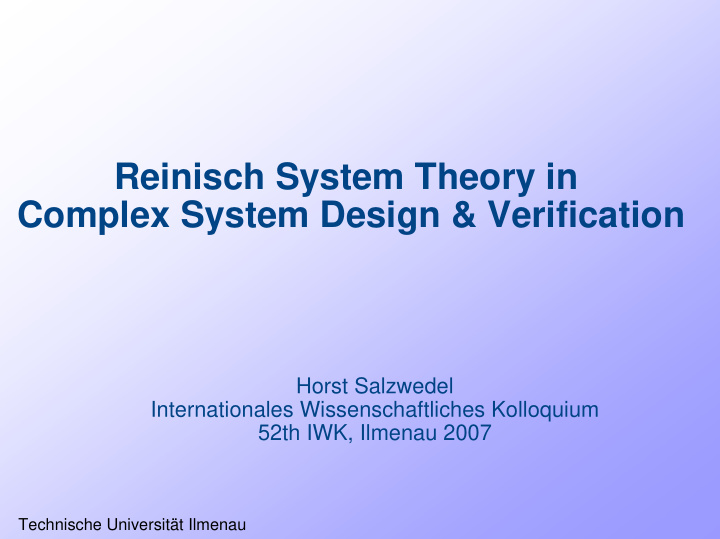



Reinisch System Theory in Complex System Design & Verification Horst Salzwedel Internationales Wissenschaftliches Kolloquium 52th IWK, Ilmenau 2007 Technische Universität Ilmenau
Agenda � Meeting Karl Reinisch � Historical development of system theory � Why do designs of complex systems fail � Next steps in system sciences to overcome these failures � Conclusions
Meeting Karl Reinisch � Fall of Berlin Wall � Leading Scientist in Automation Technology in GDR: Karl Reinisch � Invitation to Ilmenau � Invitation to join TU Ilmenau � Discussions on System Theory
How do we think? � The human mind thinks in terms of models � A model is an abstraction for and only good for the question to be answered � The model does not include more truth than has been validated � Models of different people are different � The collection of models in our brain is our knowledge
Historical Development of System Theory � Traditionally models of human thinking were passed on by word of mouth. The models changed through this type of communications. � With the introduction of paper, models were written down on scrolls. Models of different people about the same subject were different. � Up to 5000 students and scientists at the ancient library of Alexandria tried to unify the different models written down on scrolls at different countries and in different languages. They were faced with many contradictions.
Historical Development of System Theory � The introduction of books multiplied the number of models that could be written down and copied. Here Aristotle, 4th century B.C. � Caliph al Mamoun saw the importance of mathematics and added it to the House of Wisdom at Baghdad in the 9th century. He collected any book he could find in this field, and got it copied and distributed to other places and countries. � At this library al Khwarizmi introduced our way of writing numbers and algebra as a basis for unique model descriptions.
Historical Development of System Theory � In the 18th century it was realized that our knowledge of the world is limited and uncertainty in models also have to be modeled => Gauss � One of the main aims in the 19th century was to find methods on dealing with „outliers“ in model estimation from noisy measurements. � Airy (1850): Outliers should not be deleted but deweighted: => robust estimation � The introduction of feedback and filters to compensate for uncertainty in models and disturbances in many applications lead to the development of systematic methods of dealing with systems => System Theory
Complex System Design The rapid rise of electronic capabilities made many � optimistic that we could design, analyze and implement any system for enhancement of any product However, this new capability has bee used to make � systems even more complex Additionally, the complexity in designing electronic � system has been rising twice as fast as the capabilities of electronics Today, to probability of not having critical errors in � HW/SW designs is <4% Examples: Ariane V, Iridium, Teledesic, German toll � collection system, FBI IT system, networked electronics in automobiles, …
Reason for Design Failures: Product Uncertainty Paper/Picture Design Prozess Development with executable models
Why do complex system designs fail? Complex systems are designed and developed by groups of people, � departments, and/or companies The design is split when product uncertainty is still very high (often >50%) � Each group will make assumptions to overcome the uncertainty and will � consider a range of model/parameter uncertainty for design and verification of their components For design integration typically only the “best” design point of each group � is/can be integrated The uncertainty of the integrated system cannot be determined � Requirement
Solution to Complex Design Challenge � Current design approaches Executable models of specifications and standards � Executable models of design organization � Integration of design � � Problems with current approaches Designs cannot be verified to meet requirements in the � presence of product uncertainties Product integration is very time consuming and expensive � Products become too expensive in price sensitive markets �
Solution to Complex Design Challenge � Design Automation Modeling and optimization of design/organizational process � Develop models of design methodology of each group � Development of model of the integrated design and verification process � � Advantages Validated design and verification process � Rapid redesign --- automated development of customer specific design from � platform design Large reduction of risk and cost �
First results for design automation applied to aircraft avionics optimization: Performance item Reference System Optimized System Cost of architecture [$] $2,482,992.92 $707,341.63 Reduction of cables [%] 68 Weight of architecture [kg] 280.06 201.00 Weight of cables [kg] 108.21 29.15 Length of cables [feet] 1531.46 453.84 Availability 0.985309618912046 0.999999999999999
Conclusions � Karl Reinisch pointed out the generality of system theory and its usefulness in any field � Current design methodologies for complex systems have a probability on no critical errors of <4% � Failures are highly correlated to model uncertainty � Subsystem uncertainties are currently not mapped into integrated system uncertainty, so that designs are not verified � Automation of design can overcome this problem � Instead of modeling systems, methodologies from different disciplines have to be modeled to realize such a solution Questions?
Recommend
More recommend